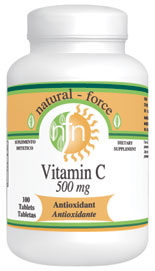
Benefits
- Helps the immune system to fight off foreign invaders and out of control cells.
- Supports the cardiovascular system.
- Facilitates fat metabolism.
- Protects tissues from free radical damage.
- Assists the nervous system by converting certain amino acids into neurotransmitters.
- Prevents scurvy.
- Is a co-factor in many biological processes.
- Protects the joints and connective tissues.
- Protects adrenal function.
Many species of animals can make their own Vitamin C, however humans must get their ascorbic acid from the foods that they eat. Supplemental Vitamin C is absorbed from the gut and then reabsorbed through the kidneys. Vitamin C can be found in a number of foods, mostly from those in the fruit and vegetable families at least 'in theory'. The only problem we have today with getting a consistent supply of Vitamin C, or any other nutrient from food sources is that foods in general are just not what they once were in terms of their native nutrient content. Many foods are grown in nutrient depleted soils and may not contain the nutrient content that is typically known to be in that product in its natural state. Some of the foods that are thought to contain Vitamin C are oranges, grapefruits, tangerines, lemons, limes, papaya, strawberries, tomatoes, broccoli, green, red bell peppers, raw lettuce, leafy greens and cantaloupe. The Vitamin C found in these fruits and vegetables are a part of the complex matrix of other ingredients, nutrients and bioflavonoids that are water soluble substances that have been shown to help protect your body from cellular damage.
Vitamin C was discovered about 66 years ago, and has gotten more press than any one nutrient since nutrition issues first came to light. Vitamin C supports some of the most important systems in our bodies. It is easy to see why this vitamin is so popular considering it has a role in everything from collagen formation to immune system function. It has been shown to prevent many illnesses; from everyday ailments such as the common cold to devastating diseases such as cancer. However Vitamin C is best known for its ability to assist in helping the immune system to fight off foreign invaders and out of control cells.
Symptoms of a deficiency may include skin problems (slow wound healing), bleeding gums, immune problems, weak or frail bone structure and chronic systemic or joint inflammation. Since Vitamin C is so important in the maintenance of the joints and connective tissues and it should be included in any formula that is used for this purpose. Many people don't realize that the immune system also has an integral part in maintaining joint health. Because when the immune system is not working properly the likelihood that the joints will become a target for invaders (chemical or other wise) is greatly increased. Vitamin C is a major component in the formation of joint collagen and synovial fluid, the cushion and fluid that helps the joints to slide and move smoothly. And since chronic inflammation is also associated with joint disease, you can see how Vitamin C has a multi-purpose function in this respect as an anti inflammatory. It also increases the level of pro-collagen messenger RNA. Collagen subunits are formed within fibroblasts as pro-collagen, which is excreted into extracellular spaces. Vitamin C is required to export the pro-collagen molecules out of the cell so they can be used.
As an antioxidant, this water-soluble nutrient is in the unique position of being able to scavenge or “gobble up” certain types of free radicals before they have a chance to damage lipids and other cellular components. It has been shown to work alongside of vitamin E, a fat-soluble antioxidant, and the enzyme glutathione peroxidase to stop the free radical chain reactions from getting out of hand. Vitamin C typically can be taken in large doses to a point, without any significant problems. Since the absorption mechanisms in the gut and kidneys can reach a saturation point, it is better to take several doses of Vitamin C throughout the day always with food, rather than one large dose.†
REFERENCES:
- Anderson R. Ascorbic acid and immune functions: mechanisms of immunostimulation. In, Counsell JN, Hornig DH (eds), Vitamin C. London, Applied Science Publishers 1981: 249-272.
- Cameron, E. and Pauling, L. (1976) Supplemental ascorbate in the supportive treatment of cancer: prolongation of survival times in terminal human cancer. Proceedings of the National Academy of Sciences USA. 73:3685-3689.
- Panush RS, Delafluente JC, Katz P, Johnson J. Modulation of certain immunologic responses by vitamin C. Ill. Potentiation of in vitro and in vivo lymphocyte responses. Int J Vitamin Nutr Res 1982; 23:35-37.
Packaging: 500 mg., 100 tablets
Back to Top
†These statements have not been evaluated by the FDA. These products are not intended to diagnose, treat, cure or prevent any disease. |